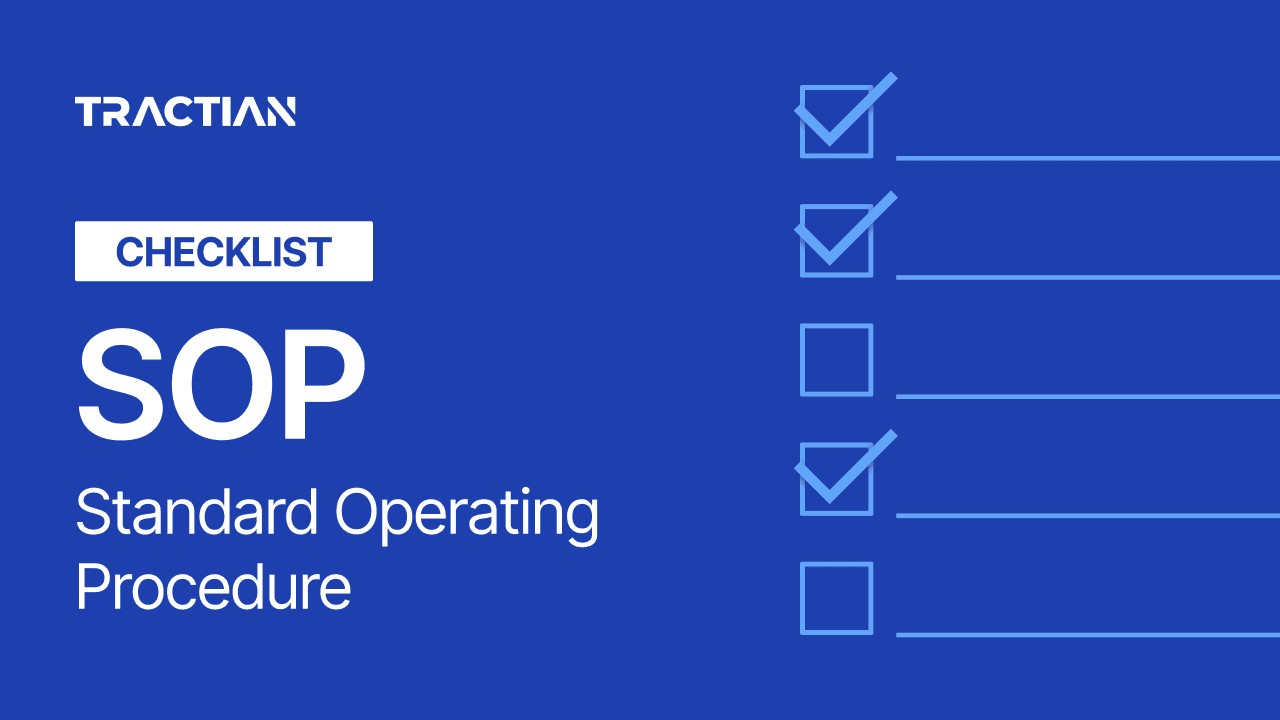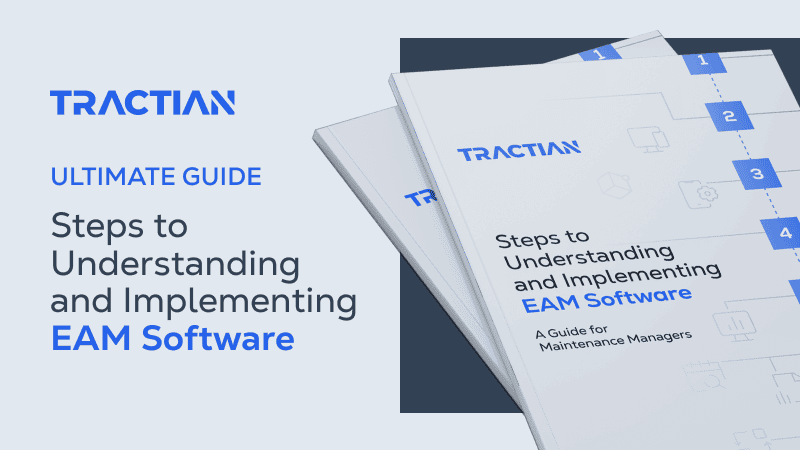Every industry that deals with repetitive tasks understands that if every operator works and completes tasks their own way, massive failures and downtime are just around the corner.
When standardization is absent in industrial settings, then rework, variability, and increasing maintenance costs will begin to dominate the operations department.
This hard-won truth is precisely why the Standard Operating Procedure (SOP) exists. SOPs are tools designed to standardize tasks, increase labor interoperability, minimize human error, and ensure the correct execution of operational activities.
In practice, an SOP is a procedural document that outlines, step by step, how a specific task should be done - by whom, with what tools, in what sequence, and under which control measures.
It’s a recipe for safe and efficient execution, designed to maintain high quality and reliability even in high-pressure environments or teams with frequent turnover.
In this article, we’ll break down how to develop, implement, and sustain standard operating procedures (SOPs) that actually work, showing how this practice can transform the way your team performs maintenance.
SOP in Business: Objectives and Benefits
An SOP is the formalization of “how to get things done” in industrial environments. It clearly defines each stage needed to perform a task, specifying team members, action sequences, tools involved, and quality assurance criteria.
The SOP's primary role is to ensure that business processes run the same way, regardless of who’s executing them - labor interoperability. That means fewer improvisations, fewer mistakes, and much more predictability in your results.
Some people reduce SOPs to a simple checklist, but they’re much more than that. A well-structured SOP is an operational guide that minimizes shift-to-shift variation, prevents rework, and directly supports safety precautions during execution.
By following a written SOP, your team avoids skipping steps or taking unnecessary risks.
Put simply, when implemented correctly, the SOP helps maintain the expected quality level in every activity, from machine setup to tightening a critical bolt. And this standardization is what builds support for asset reliability over time.
The Core Structure of an Effective SOP
A well-crafted standard operating procedure (SOP) must be clear, concise, and easy to follow. That only happens when the document is structured around the correct elements, those that define roles and responsibilities, support clarity during execution, and ensure complete alignment with company policies and operational goals.
Here are the essential components every SOP should include:
1. Scope
This defines where and when the procedure applies. It prevents the SOP from being used out of context and keeps the user tightly focused on only what’s required. A precise scope saves time and prevents misapplications.
2. Purpose
Clearly states why the procedure exists. Whether the goal is safety, efficiency, product quality, or operational consistency, this section connects the business process to its intended outcome, making it easier for the team to understand its relevance.
3. Responsibilities
Identifies who is responsible for each step. This avoids communication gaps between departments, distributes tasks correctly, and reduces the risk of someone taking over a process for which they’re not trained or authorized.
4. Required Materials and Tools
Lists everything needed to execute the task properly, from PPE to specialized tools. By identifying these resources upfront, you can avoid unnecessary pauses, ensure operations compliance, and minimize workflow deviations.
5. Execution Sequence
This is the core of any SOP, the step-by-step list that outlines the process in the correct order, with the level of detail necessary to avoid inconsistencies between different operators.
The more critical the task, the more precise this section must be. It’s a difference of how much interpretation or inference is left to the user..
6. Safety Guidelines
Every task must comply with established safety precautions. This section highlights the potential risks and the control measures required to mitigate them, especially when failures could lead to accidents or impact asset performance.
7. Review and Update Process
Defines how often the SOP should be reviewed and who is responsible for keeping it up to date. An outdated SOP can lead to regulatory noncompliance, increase safety risks, and negatively impact operations.
When each of these components is clearly defined, the SOP delivers on its promise: to standardize execution, guide teams with written instructions, and ensure that everything is consistently performed and aligned with legal, safety, and operational standards.
It also strengthens compliance, protects the business from process drift, and reduces the likelihood of avoidable errors caused by unclear procedures.
Step-by-Step: How to Implement an SOP That Actually Works
Creating a Standard Operating Procedure document that delivers real results isn’t about filling in a template. It requires a deep understanding of how the process works on the front lines, precise documentation, and ensuring the content is useful, accessible, and up to date.
In real terms, the success of an SOP has less to do with the document itself and more to do with how accurately it reflects what actually happens on your shop floor.
Here are the essential steps to structure and maintain an effective SOP:
1. Map the Process and Identify Bottlenecks
Before anything else, you need to understand how the task is being performed today-where it’s working well and where it fails. You must follow the sentiment of the entrepreneurial mantra to “get out of the building” and talk to real people. To design a great SOP, you must go to the floor where that action is. Observe people working. Document execution differences, delays, rework, and safety risks.
This SOP research phase is where the real value is discovered. Only with a direct operational diagnosis can you extract the knowledge needed to write a procedure that solves actual problems, instead of repeating inefficient habits.
2. Engage Cross-Functional Teams
An effective SOP is the product of collaboration between those who execute the task, those who supervise it, and those responsible for quality control (SOP writers). That means involving anyone who touches the process, whether they’re operators, technicians, or engineers..
When team members are part of creating the SOP, you ensure both technical consistency and practical adoption. Skip this step, and you risk resistance-or worse, wasted time because you created a procedure no one actually follows.
3. Document It Clearly and Visually
A strong SOP should be easy to read and easy to understand. Use short, clear sentences and an active voice. Whenever possible, incorporate flowcharts, diagrams, or images to enhance clarity. The best SOPs leave no room for interpretation.
They provide straightforward instructions for performing the task across shifts, regardless of the operator’s experience level.
4. Validate in the Field and Collect Feedback
Before finalizing the procedure, take it to the floor. Let real users test it. Again, to use another mantra from business start-up mentality, “try to break stuff.”
This is where you identify unclear steps, awkward sequences, or impractical requirements. The feedback from operators turns your written SOP from theory into a reliable, day-to-day tool for execution.
5. Train and Monitor Adoption
Real training doesn’t happen while listening to a presentation. True learning is practical and hands-on. Guide your team experientially through the SOP. Use that direct experience to correct misunderstandings and ensure everyone knows how to actually apply it.
After rollout, monitor the implementation. Are the routine tasks being performed according to the SOP? If not, identify the gaps and make adjustments as needed.
6. Update and Optimize Continuously
An SOP is a living document. Changes in machinery, layout, tools, or materials require immediate updates. That’s why it’s crucial to assign ownership and establish a version control process.
Ongoing updates ensure your SOP stays aligned with reality and keeps delivering value over time.

How to Apply SOPs in Industrial Maintenance
In manufacturing, standardizing processes isn’t only a production line tactic. All maintenance routines depend heavily on well-defined procedures to deliver efficiency, safety, and predictability.
A preventive maintenance SOP, for example, details exactly how inspections should be performed-what to check, with which tools, in what sequence, and under which technical parameters.
When this is clearly documented and consistently followed, results become more stable. There are fewer hidden failures, fewer surprises, and more control over equipment performance.
Well-built SOPs also help track the use of parts and materials, reduce intervention time, and improve traceability. That adds up to a more efficient, lower-cost maintenance program over time.
Dynamic SOPs for Predictive Maintenance
When it comes to predictive maintenance, standardization becomes even more essential. In this model, based on continuous monitoring and asset data, SOPs extend far beyond technical execution.
They need to incorporate automated routines for analysis, alert interpretation, and fast response to anomalies detected by sensors.
With smart solutions like those offered by Tractian, you can create operational procedures based on real-time asset behavior.
This gives life to a dynamic SOP that updates based on real-world vibration and temperature data. This elevates precision and significantly reduces unnecessary interventions.
Key Industrial Sectors and SOP Use Cases
A well-structured standard operating procedure (SOP) isn’t just useful on the production line. It forms part of the operational backbone that upholds safety, quality assurance, and efficiency across multiple industrial sectors.
Each industry comes with its own specific demands. But they all face the same core challenge: reducing human error, ensuring compliance, and maintaining consistent control over daily operations.
This is where SOPs become mission-critical, as they must adapt to the unique regulatory and operational requirements of each industrial environment.
Here’s how SOPs play out in real-world scenarios across key sectors:
Food & Beverage Industry
In this sector, the focus is on hygiene and contamination control. SOPs define strict cleaning protocols, sanitization standards, and procedures to prevent cross-contamination between batches.
They also cover routine tasks such as line checks, temperature monitoring, and equipment changeovers, ensuring regulatory requirements from entities like the FDA or HACCP are met with full traceability.
By using standard operating procedures, food and beverage facilities avoid safety violations, ensure consistent product quality, and maintain trust in high-stakes production environments.
Automotive Industry
Vehicle assembly demands absolute precision. SOPs provide step-by-step instructions for assembly procedures, critical inspections, and final validations before any component is cleared.
This level of detail reduces variability between shifts, prevents recurring defects, and ensures every unit meets the same high-quality standards, regardless of facility or technician.
These standard operating procedures (SOPs) are often tied into broader management systems to ensure continuous alignment between quality, speed, and traceability on the production floor.
Chemical Industry
In chemical processing, even minor deviations can have serious consequences. SOPs outline the procedures for handling, measuring, storing, and disposing of reagents. Every detail matters.
They also enforce safety precautions, including the use of required PPE, proper ventilation, and emergency response procedures. These written SOPs reduce risk, support regulatory compliance, and protect both personnel and the process.
This is where SOPs evolve from being written instructions to becoming critical safety frameworks that protect the business and the workforce.
Mining Industry
Heavy machinery, extreme conditions, and environmental impact risks make mining a high-stakes operation. Here, SOPs standardize everything from machine startup and shutdown to preventive maintenance routines and emergency procedures.
They also guide teams in handling sensitive tasks like tailings dam inspections or hazardous waste transport, ensuring both operational safety and environmental responsibility.
An effective SOP in mining doesn’t just help complete the tasks, it also safeguards the entire site.
Ethanol & Sugar Industry
For ethanol and sugar producers, SOPs are crucial for equipment calibration, quality control of the extraction process, and ensuring fermentation and distillation stay within operational parameters.
These process documents stabilize production outcomes, reduce raw material waste, and ensure a high product yield. By implementing SOPs that reflect real plant conditions, this sector maintains efficiency and reduces losses.
Benefits of SOPs in Industrial Environments
A well-developed standard operating procedure (SOP) acts as a powerful driver of efficiency. It structures operations, guides execution, and reinforces the standards that make repeatable performance possible, even under pressure.
Here are some of the most impactful benefits of applying SOPs in your facility:
1. Fewer Downtimes and Less Rework
Vague instructions lead to errors, errors lead to rework, and rework drains time, energy, and resources that could be used to drive productivity.
A clear, properly implemented SOP eliminates this waste cycle. It cuts down on operational mistakes, which translates into fewer unplanned shutdowns and higher equipment availability.
2. Increased Safety
When procedures are clearly defined, operational risks drop significantly. A strong SOP includes checks, correct use of PPE, and emergency protocols.
This fosters a safer working environment, lowers accident rates, and reduces team exposure to hazardous situations, which is especially important in high-risk operations.
3. Faster Learning Curve
For onboarding new team members, SOPs provide a solid, ready-to-use training foundation.
They accelerate the learning process, reduce dependence on in-person instruction, and enable new hires to meet expected standards from day one. This is especially useful in operations dealing with high turnover or complex equipment.
4. Stronger Quality Culture
Following procedures is essential for building a disciplined, quality-focused culture. When the team understands the value of adhering to standards and takes part in improving them, it lays the groundwork for continuous improvement.
The outcome is a more reliable, stable operation with reduced process variability.
Aligning SOPs with Standards and Certifications
Standardizing procedures is crucial for maintaining compliance with industry regulations and certifications.
Standards such as ISO 9001 (quality management), ISO 45001 (occupational health and safety), and ISO 14001 (environmental management) all require businesses to document their processes, assign clear responsibilities, and demonstrate that their operations follow consistent practices.
A well-built SOP delivers precisely what is needed: traceability, accountability, and consistency.
In industries with stricter regulatory demands, such as food, pharmaceutical, or chemical manufacturing, standard operating procedures are non-negotiable.
Agencies like the FDA require detailed process documentation, cleaning protocols, production records, and quality checks-all of which are structured efficiently through SOPs.
In addition to simplifying audits and inspections, SOPs also strengthen legal protection. When every task is formally documented, validated, and accessible, the company reduces noncompliance risks, avoids penalties, and prevents ambiguous interpretations.
There’s also a direct strategic advantage: documented SOPs enhance market credibility.
Businesses that run with standardized, transparent processes show operational maturity. It’s a competitive differentiator, one that improves certification readiness and strengthens brand positioning in a crowded market.
Common Challenges and Mistakes When Creating a Standard Operating Procedure (SOP)
On paper, building an effective SOP seems straightforward: document the process, standardize the steps, and make sure everyone follows the instructions.
However, in reality, many industrial teams encounter obstacles that hinder SOP effectiveness, and in some cases, create the opposite effect: increased complexity and reduced control.
Let's take a look at a few common challenges when creating a Standard Operating Procedure:
Overloading the Document
One of the most frequent mistakes is overloading SOPs with excessive formality or too much technical detail. When procedures are too long, rigid, or filled with jargon, they lose value the moment they reach the shop floor.
Instead of being a practical reference, the SOP becomes a barrier to execution.
Standard operating procedure documents that require lengthy reading or heavy interpretation often fail to work in high-pressure environments, especially in facilities with high turnover or rotating shifts. In those conditions, clarity and speed matter more than exhaustive coverage.
Excluding Frontline Workers
Another critical failure point: not involving the people who actually perform the task.
When SOPs are written exclusively by engineering or management, without input from operators or technicians, they often reflect theory more than reality. The result is a document disconnected from day-to-day practice.
This disconnect leads to informal adjustments, execution errors, and low adoption. To avoid this, SOP creation should be collaborative, involving those who live the process every day.
Skipping Regular Updates
Processes evolve, and your SOPs need to evolve with them. A lack of periodic review puts your documentation at risk of becoming outdated and irrelevant.
Whether it’s due to new equipment, layout changes, updated materials, or process improvements, SOPs must be updated accordingly. If not, they lose credibility and become just another checkbox in the management system, with no real operational value.
Handling Complexity Without Structure
Some operations are inherently complex, like working with multiple machines, high variation, tight specs, and cross-functional dependencies. Trying to manage these using spreadsheets or unstructured documents creates more chaos than control.
For operations like these, it’s critical to use SOP work tools that can scale, integrate, and automate. Relying on manual processes in high-variability environments is not only inefficient, but also unsustainable.
Take Your SOP to the Next Level with Advanced Maintenance and Monitoring Software
Creating an effective standard operating procedure (SOP) is only part of the job. To truly drive impact, it needs to be connected to what actually influences its success: the real-time condition of your assets and the operational data they generate.
Without visibility into what’s happening on the shop floor, any SOP runs the risk of remaining purely theoretical. A motor might be operating outside of acceptable parameters. A pump could be overdue for inspection. A recurring failure might go unnoticed.
And all the while, the procedure is being executed as if everything were perfectly normal.
That’s why the best path forward is combining operational standardization with advanced monitoring and asset management technology.
With Tractian’s asset management platform, you can turn your SOPs into a functional part of daily operations.
The system allows you to create customized workflows for every type of task-preventive maintenance, corrective actions, inspections, or planned shutdowns-linking each one to specific assets, responsible technicians, and performance metrics.
In practice, this means the SOP stops being a static standard operating procedure PDF stored in a network folder. It becomes an active part of a live system that tracks equipment condition, logs every action, and automatically updates the asset’s history.



